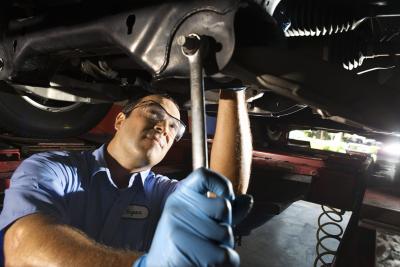
The hub bearing on your Chevy Cavalier not only supports the weight of the car, but is connected to the drive axle, by the hub assembly, to supply torque from the power train to the front wheels. Wear caused by this type of loading will lead to noisy bearings and eventual bearing failure. The bearing design used by Chevy is a sealed ball-bearing design that is not serviceable. The only recourse you have for a noisy or loose bearing is to replace it
Block the rear wheels with the wheel chocks before raising the front of the car with a floor jack positioned on the front sub-frame. Place jack stands under the front sub-frame and lower the car onto the jack stands. Remove the front wheels by unscrewing the lug nuts that attach the front wheels to the hub. Roll the floor jack from under the car and place the wheels out of the work area.
Remove the brake caliper by removing the two T45 head slide pins, using a T45 socket and ratchet, and lifting the caliper from the brake rotor. Slide the brake rotor from the front hub assembly. Unplug the ABS wheel speed sensor wiring harness from the back of the hub assembly.
Remove the axle nut, in the center of the hub assembly, using a 36-mm socket and ratchet. Attach a T45 socket to a 3-inch long extension and insert it into the large hole in the face of the hub until it engages one of the three torx head bolts that attach the hub assembly to the steering knuckle. Remove the three torx bolts and slide the hub assembly from the steering knuckle.
Install the new hub assembly into the steering knuckle and torque the retaining bolts to 70 foot-lbs using a torque wrench. Install the axle nut and torque it to 185 foot-lbs. Slide the brake rotor onto the new hub and reinstall the caliper. Tighten the caliper slide pins securely.
Reinstall the wheels and torque the lug nuts to 80 foot-lbs. Raise the car off the stands using the floor jack, and remove the stands before slowly lowering the car to the ground. Re-torque the lug nuts one final time.